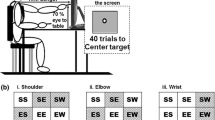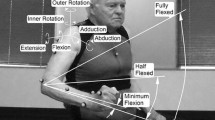Abstract
The purpose of this study was to determine the influence of workspace location on joint coordination in persons with post-stroke hemiparesis when trunk motion was required to complete reaches beyond the arm’s functional reach length. Seven subjects with mild right hemiparesis following a stroke and seven age and gender matched control subjects participated. Joint motions and characteristics of hand and trunk movement were measured over multiple repetitions. The variance (across trials) of joint combinations was partitioned into two components at every point in the hand’s trajectory using the uncontrolled manifold approach; the first component is a measure of the extent to which equivalent joint combinations are used to control a given hand path, and reflects performance flexibility. The second component of joint variance reflects the use of non-equivalent joint combinations, which lead to hand path error. Compared to the control subjects, persons with hemiparesis demonstrated a significantly greater amount of non-equivalent joint variability related to control of the hand’s path and of the hand’s position relative to the trunk when reaching toward the hemiparetic side (ipsilaterally), but not when reaching to the less involved side. The relative timing of the hand and trunk was also altered when reaching ipsilaterally. The current findings support the idea that the previously proposed “arm compensatory synergy” may be deficient in subjects with hemiparesis. This deficiency may be due to one or a combination of factors: changes in central commands that are thought to set the gain of the arm compensatory synergy; a limited ability to combine shoulder abduction and elbow extension that limits the expression of an appropriately set arm compensatory synergy; or a reduction of the necessary degrees-of-freedom needed to adequately compensate for poor trunk control when reaching ipsilaterally.







Similar content being viewed by others
References
Adamovich SV, Archambault PS, Ghafouri M, Levin MF, Poizner H, Feldman AG (2001) Hand trajectory invariance in reaching movements involving the trunk. Exp Brain Res 138:288–303
Archambault P, Pigeon P, Feldman AG, Levin MF (1999) Recruitment and sequencing of different degrees of freedom during pointing movements involving the trunk in healthy and hemiparetic subjects. Exp Brain Res 126:55–67
Beer RF, Dewald JP, Dawson ML, Rymer WZ (2004) Target-dependent differences between free and constrained arm movements in chronic hemiparesis. Exp Brain Res 156:458–470
Beer RF, Dewald JP, Rymer WZ (2000) Deficits in the coordination of multijoint arm movements in patients with hemiparesis: evidence for disturbed control of limb dynamics. Exp Brain Res 131:305–319
Beer RF, Given JD, Dewald JP (1999) Task-dependent weakness at the elbow in patients with hemiparesis. Arch Phys Med Rehabil 80:766–772
Cirstea MC, Levin MF (2000) Compensatory strategies for reaching in stroke. Brain 123(Pt 5):940–953
Dewald JP, Beer RF (2001) Abnormal joint torque patterns in the paretic upper limb of subjects with hemiparesis. Muscle Nerve 24:273–283
Domkin D, Laczko J, Jaric S, Johansson H, Latash ML (2002) Structure of joint variability in bimanual pointing tasks. Exp Brain Res 143:11–23
Folstein MF, Folstein SE, McHugh PR (1975) “Mini-mental state”. A practical method for grading the cognitive state of patients for the clinician. J Psychiatr Res 12:189–198
Fugl-Meyer AR, Jaasko L, Leyman I, Olsson S, Steglind S (1975) The post-stroke hemiplegic patient. 1. A method for evaluation of physical performance. Scand J Rehabil Med 7:13–31
Lai SM, Duncan PW, Keighley J (1998) Prediction of functional outcome after stroke: comparison of the Orpington Prognostic Scale and the NIH Stroke Scale. Stroke 29:1838–1842
Latash ML, Danion F, Scholz JF, Zatsiorsky VM, Schoner G (2003) Approaches to analysis of handwriting as a task of coordinating a redundant motor system. Hum Mov Sci 22:153–171
Levin MF, Michaelsen SM, Cirstea CM, Roby-Brami A (2002) Use of the trunk for reaching targets placed within and beyond the reach in adult hemiparesis. Exp Brain Res 143:171–180
Lindmark B, Hamrin E (1988) Evaluation of functional capacity after stroke as a basis for active intervention. Presentation of a modified chart for motor capacity assessment and its reliability. Scand J Rehabil Med 20:103–109
Ma S, Feldman AG (1995) Two functionally different synergies during arm reaching movements involving the trunk. J Neurophysiol 73:2120–2122
Michaelsen SM, Luta A, Roby-Brami A, Levin MF (2001) Effect of trunk restraint on the recovery of reaching movements in hemiparetic patients. Stroke 32:1875–1883
Murray R, Li Z, Sastry SS (1994) A mathematical introduction to robotic manipulation. CRC Press, London
Pigeon P, Yahia LH, Mitnitski AB, Feldman AG (2000) Superposition of independent units of coordination during pointing movements involving the trunk with and without visual feedback. Exp Brain Res 131:336–349
Reisman DS, Scholz JP (2003) Aspects of joint coordination are preserved during pointing in persons with post-stroke hemiparesis. Brain 126:2510–2527
Reisman DS, Scholz JP, Schoner G (2002a) Coordination underlying the control of whole body momentum during sit-to-stand. Gait Posture 15:45–55
Reisman DS, Scholz JP, Schoner G (2002b) Differential joint coordination in the tasks of standing up and sitting down. J Electromyogr Kinesiol 12:493–505
Roby-Brami A, Feydy A, Combeaud M, Biryukova EV, Bussel B, Levin MF (2003) Motor compensation and recovery for reaching in stroke patients. Acta Neurol Scand 107:369–381
Rossi E, Mitnitski A, Feldman AG (2002) Sequential control signals determine arm and trunk contributions to hand transport during reaching in humans. J Physiol 538:659–671
Saling M, Stelmach GE, Mescheriakov S, Berger M (1996) Prehension with trunk assisted reaching. Behav Brain Res 80:153–160
Scholz JP, Danion F, Latash ML, Schoner G (2002) Understanding finger coordination through analysis of the structure of force variability. Biol Cybern 86:29–39
Scholz JP, Schoner G (1999) The uncontrolled manifold concept: identifying control variables for a functional task. Exp Brain Res 126:289–306
Scholz JP, Schoner G, Latash ML (2000) Identifying the control structure of multijoint coordination during pistol shooting. Exp Brain Res 135:382–404
Shumway-Cook A, Baldwin M, Polissar NL, Gruber W (1997) Predicting the probability for falls in community-dwelling older adults. Phys Ther 77:812–819
Soderkvist I, Wedin PA (1993) Determining the movements of the skeleton using well-configured markers. J Biomech 26:1473–1477
Tseng Y, Scholz JP, Schoner G (2002) Goal-equivalent joint coordination in pointing: affect of vision and arm dominance. Motor Control 6:183–207
Wang J, Stelmach GE (1998) Coordination among the body segments during reach-to-grasp action involving the trunk. Exp Brain Res 123:346–350
Acknowledgements
Support for this work was provided to Dr. Scholz grant NS-050880 from the National Institutes of Health.
Author information
Authors and Affiliations
Corresponding author
Appendix
Appendix
The initial step in estimating GEV and NGEV is to obtain the geometric model relating the task-related variable, r, (e.g., the position of the hand) to the joint configuration θ. This is done using the product of exponentials formula (Murray et al. 1994). The state-space configuration for the hypothesis about controlling the position of the hand is, in our experiment, composed of 16 angles (three at the scapula, shoulder, hip and lumbosacral joints, two at the elbow—flexion–extension and pronation–supination, two at the wrist—flexion–extension and abduction–adduction).
Small changes in r are related to changes in θ through the Jacobian, which is the matrix of partial derivatives of the task variable, r, with respect to the joint angles, θ. For example, if the task variable under consideration is the position of the hand, the geometric model relating hand position and the joint configuration is
where, Hand is the three-dimensional position of the hand, \( {\mathbf{R}}_{{{\mathbf{\theta }}_{{\mathbf{i}}} }} \) is the rotation matrix associated with rotation about the first axis of the first joint contributing to the position of the hand and \( {\mathbf{R}}_{{{\mathbf{\theta }}_{{\mathbf{n}}} }} \) is the rotation matrix associated with rotation about the last axis of last joint contributing to the position of hand.. The variable d i is the distance from the origin of the body referenced coordinate system (foot marker) to the joint proximal to the hand (wrist) and sl h is the length from the wrist to the anterior-most hand marker. \( {\mathbf{p}}_{{{\mathbf{\theta }}_{{\mathbf{i}}} }} \) is the translation vector associated with rotation about the first axis of the first joint contributing to the position of hand (that is, the first joint proximal to the base frame), \( {\mathbf{p}}_{{{\mathbf{\theta }}_{{\mathbf{n}}} }} \) is the translation vector associated with rotation about the last axis of the last joint contributing to the to the position of the hand.
The second step is to estimate the linear approximation to the UCM from the geometric model. Because the UCM differs for each value of the task variable, a decision is necessary as to what value to use for the estimation. In reality, both joint configurations and task variables vary from trial to trial. Based on the assumption that the normalization of movement time has aligned matching states of the underlying joint space across trials, we compute the mean joint configuration, \( {\mathbf{\underset{\raise0.3em\hbox{$\smash{\scriptscriptstyle-}$}}{\theta } }} \) at each percent of the movement. Effectively, the value of the task variable, \( \underline{{\mathbf{r}}} \), associated with that mean joint configuration is represented by the UCM. Again, continuing with the example for the hand position, the linear approximation to the UCM was obtained from the geometrical model, linearized around the mean joint configuration:
Here, \( \underline{\underline {\mathbf{J}}} \) is the Jacobian, composed of ∂r/∂θ i , where i={hip, LSJ, scapular, shoulder, elbow and wrist joint angles}, obtained at each point in sampled time. The linear approximation of the UCM is then the null-space of the Jacobian (the linear subspace of all deviations from the mean joint configuration that are mapped onto zero by the Jacobian). Using Matlab™ for the numerical computation of the null-space, the actual value of the joint configuration minus the mean joint configuration at each point along the movement path of each trial is decomposed into a component that lies within this null space and a component in its complement. The components of the deviation vector of the joint configuration lying within the UCM and those in its complement are then squared, summed across dimensions of the UCM (i.e., sum of squares), and averaged across all trials, resulting in variance measures. The estimates of variance were then divided by the appropriate number of DOF. For example, for the hypothesis about controlling the hand position, the joint configuration space is 16-dimensional and the task variable is three-dimensional. Therefore, the null space has 13 dimensions. Thus, variance of the joint configuration within the UCM is divided by 13. The variance perpendicular to the UCM (i.e., variance that changes the value of the task variable from its mean value) is divided by three. This normalized variance is reported as variance per DOF within the UCM (or GEV) and orthogonal to the UCM (NGEV).
Rights and permissions
About this article
Cite this article
Reisman, D.S., Scholz, J.P. Workspace location influences joint coordination during reaching in post-stroke hemiparesis. Exp Brain Res 170, 265–276 (2006). https://doi.org/10.1007/s00221-005-0209-5
Received:
Accepted:
Published:
Issue Date:
DOI: https://doi.org/10.1007/s00221-005-0209-5




